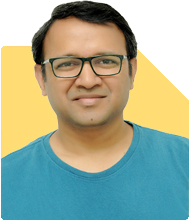Ramalingam Kalirajan |10852 Answers |Ask -Follow
Mutual Funds, Financial Planning Expert - Answered on Jun 25, 2024
He has an MBA in finance from the University of Madras and is a certified financial planner.
He is the director and chief financial planner at Holistic Investment, a Chennai-based firm that offers financial planning and wealth management advice.... more

Hi , I am 33 years old with monthly intake of around 1.75 lakh. My current MF portfolio is around 20 lakh, and equity portfolio is around 3 lakh. PF and PPF of around 10 lakh each. My monthly sip is around 70k. How can I get to 2 crore by age of 40 ?
Current Financial Overview
Your monthly income is Rs. 1.75 lakhs, which provides a solid base for savings and investments. Your current portfolio includes:
Mutual Funds: Rs. 20 lakhs
Equities: Rs. 3 lakhs
PF: Rs. 10 lakhs
PPF: Rs. 10 lakhs
Monthly SIP: Rs. 70,000
Your goal is to accumulate Rs. 2 crore in the next seven years, by the age of 40.
Analyzing Your Investments
Mutual Funds
Your mutual fund portfolio of Rs. 20 lakhs is substantial. Since you’re investing Rs. 70,000 per month through SIPs, you’re leveraging the power of rupee cost averaging. This strategy helps mitigate market volatility. Let’s ensure your mutual fund selection is optimized:
Equity Mutual Funds: Given your age and the time horizon, a higher allocation to equity mutual funds is beneficial. These funds tend to offer higher returns over the long term.
Debt Mutual Funds: A smaller portion in debt mutual funds can provide stability and reduce risk.
Equities
With Rs. 3 lakhs in equities, you’re directly exposed to the stock market. This exposure can yield high returns, but it also comes with higher risk. Diversification is key. Ensure your portfolio includes stocks from various sectors to spread risk.
Provident Fund (PF) and Public Provident Fund (PPF)
Your investments in PF and PPF, totaling Rs. 20 lakhs, are excellent for securing a stable and tax-efficient retirement corpus. These instruments offer steady, guaranteed returns and should continue to be a part of your long-term strategy.
Steps to Achieve Rs. 2 Crore by Age 40
Increase SIP Contributions
Currently, you’re investing Rs. 70,000 monthly in SIPs. If feasible, consider gradually increasing this amount. Even a small increase can significantly impact your corpus due to the compounding effect.
Optimize Mutual Fund Portfolio
Focus on Actively Managed Funds
Equity Focus: Concentrate on actively managed equity funds with a proven track record. These funds, managed by skilled professionals, can potentially outperform the market.
Diversification: Diversify your mutual fund investments across large-cap, mid-cap, and small-cap funds. This diversification can balance risk and reward.
Regular Review and Rebalancing
Periodic Review: Regularly review your portfolio to ensure it aligns with your financial goals. Adjust your investments based on market conditions and performance.
Rebalancing: Rebalance your portfolio periodically to maintain your desired asset allocation. This process involves selling overperforming assets and reinvesting in underperforming ones.
Enhance Equity Investments
Diversify Holdings: Diversify your equity holdings to mitigate risk. Include stocks from different sectors and industries.
Regular Monitoring: Keep a close eye on your equity investments. Stay informed about market trends and company performance.
Consult a Certified Financial Planner: For personalized advice, consider consulting a Certified Financial Planner. They can provide insights based on your specific financial situation.
Leverage PF and PPF Benefits
Maximize Contributions: Continue maximizing your contributions to PF and PPF. These investments offer tax benefits and secure returns.
Long-term Focus: Maintain a long-term focus for these investments. Avoid withdrawals unless absolutely necessary to allow compounding to work in your favor.
Additional Investment Strategies
Explore Hybrid Funds
Balanced Approach: Hybrid funds, which invest in both equities and debt, offer a balanced approach. They provide growth potential with reduced risk.
Risk Management: These funds can help manage risk while still aiming for reasonable returns.
Invest in ELSS for Tax Benefits
Tax-saving Funds: Equity Linked Savings Schemes (ELSS) provide tax benefits under Section 80C. They have a lock-in period of three years and can offer good returns.
Dual Benefit: ELSS investments offer the dual benefit of tax saving and wealth creation.
Financial Discipline
Emergency Fund
Safety Net: Maintain an emergency fund covering 6-12 months of expenses. This fund acts as a safety net for unexpected expenses.
Liquidity: Ensure this fund is liquid and easily accessible in case of emergencies.
Avoid Unnecessary Debt
Debt Management: Avoid accumulating unnecessary debt. High-interest debt can erode your savings and investments.
Smart Borrowing: If borrowing is necessary, opt for low-interest options and ensure you can comfortably manage repayments.
Investment Monitoring and Adjustment
Regular Reviews
Quarterly Review: Conduct quarterly reviews of your investment portfolio. Assess the performance and make necessary adjustments.
Stay Informed: Stay informed about market trends and economic changes. This knowledge helps in making informed investment decisions.
Professional Guidance
Certified Financial Planner: Consulting a Certified Financial Planner can provide personalized advice. They can help optimize your investment strategy based on your goals and risk tolerance.
Continuous Learning: Continuously educate yourself about personal finance and investment strategies. This knowledge empowers you to make informed decisions.
Assessing Risk Tolerance
Risk Profile: Understand your risk tolerance and investment horizon. This understanding helps in selecting the right mix of investments.
Adjustments: Make adjustments to your portfolio based on changes in your risk tolerance or financial goals.
Tracking Progress Towards Your Goal
Setting Milestones
Intermediate Goals: Set intermediate financial milestones. This helps in tracking progress and staying motivated.
Celebrate Achievements: Celebrate achieving these milestones. This positive reinforcement encourages continued discipline.
Adjusting Strategy as Needed
Flexibility: Be flexible and willing to adjust your strategy as needed. Market conditions and personal circumstances may change.
Stay Focused: Stay focused on your long-term goal. Avoid making impulsive decisions based on short-term market fluctuations.
Final Insights
Achieving your goal of Rs. 2 crore by the age of 40 is ambitious but attainable with disciplined planning and strategic investments. Your current investment portfolio and SIP contributions provide a strong foundation. Consider increasing your monthly SIP contributions and focusing on actively managed equity mutual funds for higher returns. Diversify your equity investments and regularly review and rebalance your portfolio. Maximize contributions to tax-efficient instruments like PF, PPF, and ELSS.
Maintaining financial discipline, avoiding unnecessary debt, and consulting a Certified Financial Planner can further enhance your strategy. Set intermediate milestones to track your progress and stay motivated. Flexibility and continuous learning will empower you to adapt to changing market conditions and personal circumstances. With the right approach, you can achieve your financial goal and secure a prosperous future.
Best Regards,
K. Ramalingam, MBA, CFP
Chief Financial Planner
www.holisticinvestment.in
You may like to see similar questions and answers below
Ramalingam Kalirajan |10852 Answers |Ask -Follow
Mutual Funds, Financial Planning Expert - Answered on May 12, 2024
Ramalingam Kalirajan |10852 Answers |Ask -Follow
Mutual Funds, Financial Planning Expert - Answered on May 17, 2024
Ramalingam Kalirajan |10852 Answers |Ask -Follow
Mutual Funds, Financial Planning Expert - Answered on May 20, 2024
Ramalingam Kalirajan |10852 Answers |Ask -Follow
Mutual Funds, Financial Planning Expert - Answered on Jul 10, 2024
Ramalingam Kalirajan |10852 Answers |Ask -Follow
Mutual Funds, Financial Planning Expert - Answered on Mar 04, 2025
Ramalingam Kalirajan |10852 Answers |Ask -Follow
Mutual Funds, Financial Planning Expert - Answered on Nov 21, 2025
Reetika Sharma |375 Answers |Ask -Follow
Financial Planner, MF and Insurance Expert - Answered on Nov 21, 2025
Radheshyam Zanwar |6718 Answers |Ask -Follow
MHT-CET, IIT-JEE, NEET-UG Expert - Answered on Nov 21, 2025
Reetika Sharma |375 Answers |Ask -Follow
Financial Planner, MF and Insurance Expert - Answered on Nov 21, 2025
Radheshyam Zanwar |6718 Answers |Ask -Follow
MHT-CET, IIT-JEE, NEET-UG Expert - Answered on Nov 21, 2025
Dr Nagarajan J S K |2569 Answers |Ask -Follow
NEET, Medical, Pharmacy Careers - Answered on Nov 21, 2025
Radheshyam Zanwar |6718 Answers |Ask -Follow
MHT-CET, IIT-JEE, NEET-UG Expert - Answered on Nov 21, 2025
Radheshyam Zanwar |6718 Answers |Ask -Follow
MHT-CET, IIT-JEE, NEET-UG Expert - Answered on Nov 21, 2025
Dr Dipankar Dutta |1832 Answers |Ask -Follow
Tech Careers and Skill Development Expert - Answered on Nov 20, 2025
Patrick Dsouza |1417 Answers |Ask -Follow
CAT, XAT, CMAT, CET Expert - Answered on Nov 20, 2025


























